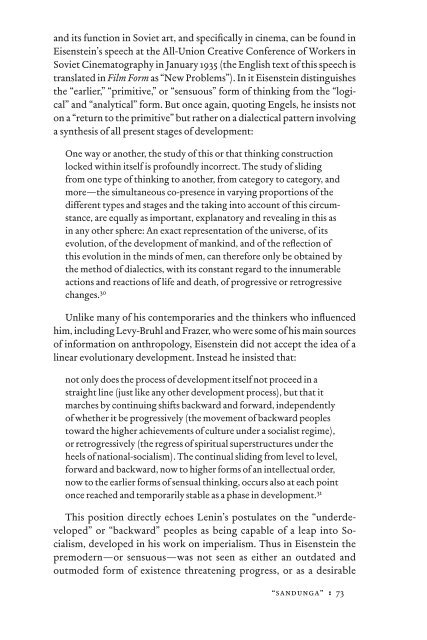In Excess: Sergei Eisentein's Mexico - Cineclub
In Excess: Sergei Eisentein's Mexico - Cineclub
In Excess: Sergei Eisentein's Mexico - Cineclub
You also want an ePaper? Increase the reach of your titles
YUMPU automatically turns print PDFs into web optimized ePapers that Google loves.
and its function in Soviet art, and specifi cally in cinema, can be found in<br />
Eisenstein’s speech at the All-Union Creative Conference of Workers in<br />
Soviet Cinematography in January 1935 (the English text of this speech is<br />
translated in Film Form as “New Problems”). <strong>In</strong> it Eisenstein distinguishes<br />
the “earlier,” “primitive,” or “sensuous” form of thinking from the “logical”<br />
and “analytical” form. But once again, quoting Engels, he insists not<br />
on a “return to the primitive” but rather on a dialectical pattern involving<br />
a synthesis of all present stages of development:<br />
One way or another, the study of this or that thinking construction<br />
locked within itself is profoundly incorrect. The study of sliding<br />
from one type of thinking to another, from category to category, and<br />
more—the simultaneous co-presence in varying proportions of the<br />
different types and stages and the taking into account of this circumstance,<br />
are equally as important, explanatory and revealing in this as<br />
in any other sphere: An exact representation of the universe, of its<br />
evolution, of the development of mankind, and of the refl ection of<br />
this evolution in the minds of men, can therefore only be obtained by<br />
the method of dialectics, with its constant regard to the innumerable<br />
actions and reactions of life and death, of progressive or retrogressive<br />
changes. 30<br />
Unlike many of his contemporaries and the thinkers who infl uenced<br />
him, including Levy-Bruhl and Frazer, who were some of his main sources<br />
of information on anthropology, Eisenstein did not accept the idea of a<br />
linear evolutionary development. <strong>In</strong>stead he insisted that:<br />
not only does the process of development itself not proceed in a<br />
straight line (just like any other development process), but that it<br />
marches by continuing shifts backward and forward, independently<br />
of whether it be progressively (the movement of backward peoples<br />
toward the higher achievements of culture under a socialist regime),<br />
or retrogressively (the regress of spiritual superstructures under the<br />
heels of national-socialism). The continual sliding from level to level,<br />
forward and backward, now to higher forms of an intellectual order,<br />
now to the earlier forms of sensual thinking, occurs also at each point<br />
once reached and temporarily stable as a phase in development. 31<br />
This position directly echoes Lenin’s postulates on the “underdeveloped”<br />
or “backward” peoples as being capable of a leap into Socialism,<br />
developed in his work on imperialism. Thus in Eisenstein the<br />
premodern—or sensuous—was not seen as either an outdated and<br />
outmoded form of existence threatening progress, or as a desirable<br />
“sandunga” : 73


